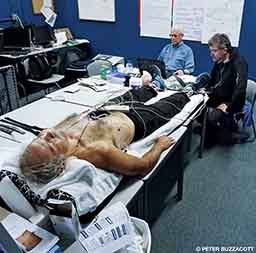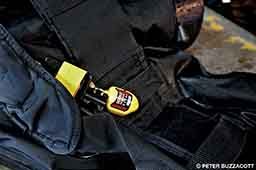In October 2017 I was part of a team of five researchers from DAN® who traveled to the Oregon Coast Aquarium (OCA) in Newport, Ore., to meet with members of its volunteer diving program. Nearly a quarter of the 120 dive volunteers offered to participate in an ongoing DAN study about the potential effects of diving on the heart.
The study is designed to investigate whether diving can cause irregular heartbeats or an increase in the mass of the left ventricle, which is known as left ventricular hypertrophy (LVH). LVH may be found in people with hypertension and other changes in circulation that cause the heart to work against increased resistance. The condition is considered a risk factor for irregular heart rhythms, some of which could lead to sudden cardiac death in divers. Because the cold-water exhibits at the aquarium require divers to wear drysuits, the trip to OCA provided the perfect opportunity to gather clean data from Holter electrocardiogram (EKG) monitors, which in previous studies had been worn under wetsuits.

volunteer diver’s heart function.
Our workstation for the week was a borrowed youth volunteer room, which we transformed into a makeshift lab with stations that offered privacy and quiet for each participant. We saw five or six participants each day, meeting with them both before and after their daily dive activities. Predive, we measured their blood pressure, completed echocardiograms, attached electrodes for twelve-lead EKGs and Holter monitors and completed resting predive EKGs. The volunteers then performed their dives and associated tasks while wearing their Holter monitors and sensitive dive loggers to record temperature, depth and ascent rate. After their dives, they returned to us for postdive measurements.
The size and extent of the OCA’s volunteer dive program is impressive, particularly considering its location distant from major metropolitan areas and its relatively small size. The volunteer program is a self-organized entity led by diving safety officers Jenna Walker and Doug Batson. OCA volunteers complete a variety of daily tasks: wiping the acrylic aquarium windows, vacuuming the bottoms of the tanks, scrubbing rocks, changing aquatic decor, feeding and tracking the health of the fish and even setting up marriage proposals in the Passages of the Deep exhibit. These divers need to be competent and confident in their skills — especially because the water in the exhibits can be as cold as 45°F.

Before volunteering at the aquarium, prospective participants need to complete rigorous swim tests, pool training and training dives in the aquarium, in addition to completing and maintaining certification in the DAN Diving First Aid for Professional Divers (DFA Pro) course. Once they become volunteers, they must pass an American Academy of Underwater Sciences (AAUS) physical every two years. For anyone over the age of 40, this physical includes an EKG, chest X-ray and coronary risk-factor assessment. Because 80 percent of the volunteers are 55 or older, this rigorous exam applies to most of the dive team.
With all the relevant risk factors, the OCA’s diving program is very safety conscious. They run emergency drills multiple times per year, preparing divers for sprained ankles, shark bites, tsunamis and everything in between. Although volunteers may choose to opt out of the drills, it is rare that they do so. These divers understand how important practice and preparation are for real-life emergencies. In the past 17 years there has been only one major incident at the OCA, and because of the rehearsals of their emergency action plans, the team acted quickly and helped the person survive a life-threatening situation. Due in large part to the program’s focus on safety, the divers are uniformly confident, relaxed and able to do exemplary work. Although their aquarium may not be the largest in the country, their protocols and ideals serve as an outstanding example to all other volunteer dive programs.
Despite the hard work, constant training and cold water, these volunteers love what they do. Some have been diving with the OCA volunteer program since its inception in 2000, and many drive for hours just to get to the aquarium to complete their shift. When asked why they continue to volunteer, many of them had the same answers: It is a great way to keep diving year-round and into retirement; it is the best diving in Oregon, with perfect visibility and calm water; it keeps your skills sharp; and the work is always interesting and different.

water temperature.
One of the aquarium’s priorities is to make the underwater world accessible to nondivers, which the OCA does through an interpretive diving program. This program involves a volunteer diver equipped with a full-face mask and microphone diving into the Open Ocean tank with more than 100 sharks, interacting with a roomful of visitors and answering their questions in real time. The primary goal is to educate the public about the marine life in the tanks, but it also exposes people to diving.
In addition to being well prepared and competent, what most distinguishes OCA dive volunteers is their camaraderie. Instead of showing up for just one dive shift, volunteers frequently come to the aquarium and spend the whole day there with their team. Team members become more than coworkers, and the group has evolved into a diving community of its own. This closeness breeds positivity and means every member is individually dedicated to the aquarium and its mission.
“The program only survives by the dedication of the volunteers,” Walker explained.
We visited the OCA for research purposes and left in awe of their volunteer dive program. Their dedication to continuous training and promoting a culture of dive safety and their cheerful tolerance of frigid water are inspiring. Their eagerness to assist us with our research made our work easy and extremely enjoyable. It is our hope that data collected from this unique team will not only help shed light on how diving affects the human body but also highlight how to run a successful volunteer dive operation.
| © Alert Diver — Q1 2018 |